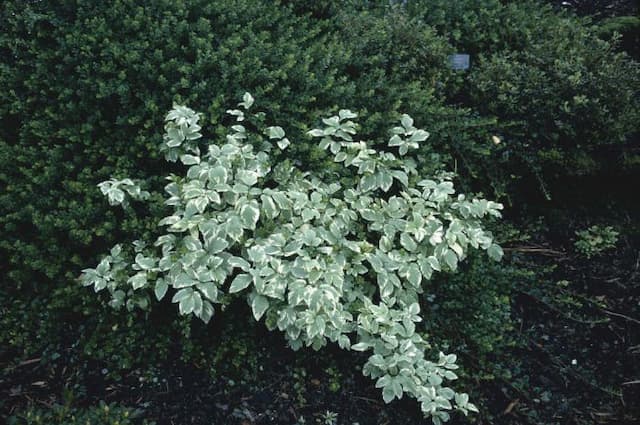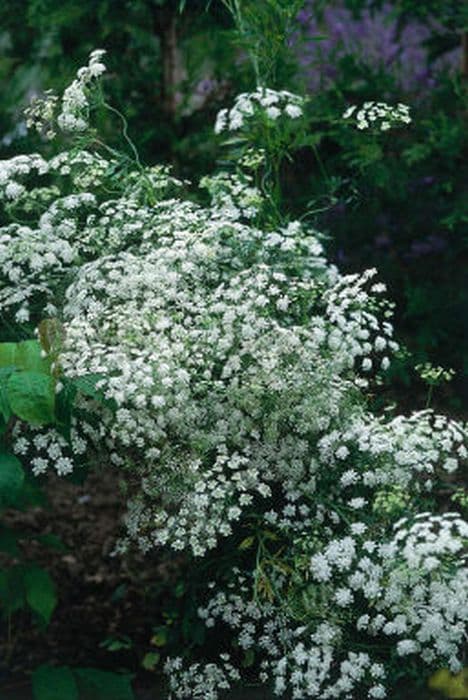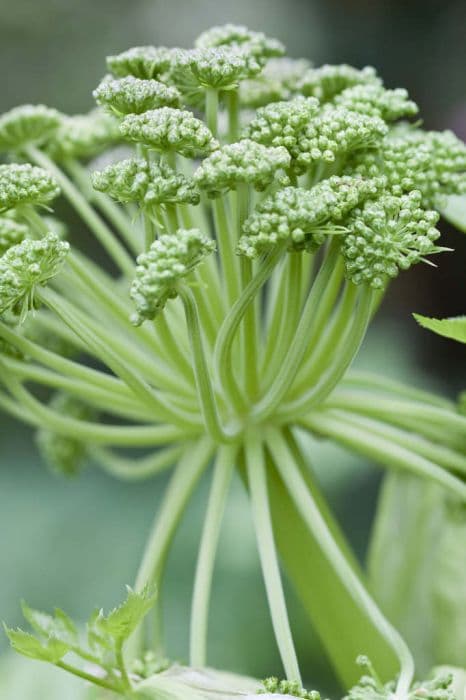Sweet Cicely Myrrhis odorata






ABOUT
Myrrhis odorata, commonly known as sweet cicely, is an herbaceous perennial plant that is distinguished by its lacy, fern-like foliage. The leaves are bright green and have a delicate, finely divided appearance, with a soft texture that can be both visually and tactilely appealing. The plant's stems are hollow and grooved, carrying the leaves which are arranged in a compound structure. Sweet cicely produces cluster of small, white flowers that are grouped in umbels, giving it a frothy, delicate look when in bloom. The flowers eventually give way to long, slender, dark-colored seeds that are notable for their sweet, anise-like fragrance and flavor which gives the plant its common name. The entire plant is aromatic, and when bruised or crushed, it emits a pleasant, sweet smell that is reminiscent of anise or licorice. Overall, sweet cicely has an attractive, green, and white display that can add both visual interest and fragrance to garden settings.
About this plant
 Names
NamesSynonyms
Sweet Cicely, Garden Myrrh, Sweet Chervil, British Myrrh, Cicely, Cow Chervil, Shepherd's Needle, Sweet-Scented Myrrh, Sweet Fern, Wild Chervil.
Common names
Chaerophyllum odoratum, Scandix odorata, Selinum myrrhis, Myrrhis cordata, Cicuta myrrhis, Aethusa myrrhis, Seseli odoratum, Ligusticum myrrhidis.
 Toxicity
ToxicityTo humans
The common name for Myrrhis odorata is Sweet Cicely. Sweet Cicely is not considered toxic to humans and is actually used as a herb in cooking and for medicinal purposes. However, as with any plant, some individuals may have allergic reactions or sensitivities to it. It is always recommended to exercise caution and consult a medical professional if you're considering using any plant for medicinal purposes or if you experience any adverse reactions after handling or ingesting it.
To pets
Sweet Cicely is not commonly known to be toxic to pets. As with humans, it is considered a herb and does not typically pose a risk when ingested by animals in small quantities. However, individual sensitivities and allergic reactions can occur in pets just like in humans. Always monitor your pets when they are around plants, and if you suspect your pet has ingested a large amount or is showing signs of illness, contact your veterinarian immediately.
 Characteristics
CharacteristicsLife cycle
Biennials
Foliage type
Deciduous
Color of leaves
Green
Flower color
White
Height
2-3 feet (0.6-0.9 meters)
Spread
1-2 feet (0.3-0.6 meters)
Plant type
Herb
Hardiness zones
4
Native area
Europe
Benefits
 General Benefits
General Benefits- Culinary Uses: Sweet Cicely leaves can be used fresh or dried to flavor desserts, liqueurs, and savoury dishes, imparting a sweet, anise-like taste.
- Garden Aesthetics: With its fern-like foliage and white flowers, Sweet Cicely can add ornamental value to gardens and landscapes.
- Companion Planting: Sweet Cicely is believed to enhance the growth and flavor of certain vegetables and herbs when planted nearby.
- Soil Improvement: As a deep-rooted plant, Sweet Cicely can help improve soil structure by loosening compacted soils with its roots.
- Wildlife Attraction: The flowers of Sweet Cicely can attract beneficial insects such as bees, which are important for pollination in the garden.
- Aromatic Properties: The plant emits a pleasant aroma, which can be enjoyable in the garden or when used in potpourris and scented sachets.
- Edible Flowers: The white flowers of Sweet Cicely are edible and can be used as a decorative and flavorful addition to salads and other dishes.
 Medical Properties
Medical Properties- Antispasmodic: Myrrhis odorata is traditionally used to help relieve spasms in the digestive tract.
- Carminative: It is believed to aid in the reduction of gas in the gastrointestinal system.
- Diuretic: The plant has been used to increase urine flow and relieve fluid retention.
- Expectorant: Has been used to help clear mucus from the respiratory tract.
- Stimulant: It is sometimes used to stimulate the digestive system or other bodily processes.
- Aromatic: The plant's strong scent is believed to have a mild soothing effect when used in aromatherapy.
 Air-purifying Qualities
Air-purifying QualitiesThis plant is not specifically known for air purifying qualities.
 Other Uses
Other Uses- Insect Repellent: The strong aromatic scent of Myrrhis odorata, commonly known as sweet cicely, can deter insects naturally.
- Companion Planting: Sweet cicely can be planted alongside fruit trees to improve pollination and fruit flavor due to its attraction of beneficial insects.
- Culinary Sweetener: The leaves of sweet cicely can be used as a natural sweetener in cooking and baking, providing a licorice-like flavor.
- Aromatic Herb: Its fragrant leaves are utilized in potpourris and scented sachets to impart a pleasant aroma in drawers and closets.
- Decorative Use: With its delicate white flowers and fern-like foliage, sweet cicely is used in flower arrangements and garden landscaping.
- Flavor Enhancer: The plant is known to reduce the acidity in fruit dishes, thus being used in preparations of fruit salads and compotes.
- Natural Cleaner: The leaves of sweet cicely can be infused in water to create a gentle, natural cleaning solution for delicate surfaces.
- Dye Plant: Sweet cicely can be used as a natural dye source, yielding a greenish-yellow color when used with wool or other natural fabrics.
- Dog Repellent: Some gardeners use the plant's strong smell to keep dogs from digging in garden areas.
- Soil Improvement: Sweet cicely is believed to enrich soil by accumulating minerals, which later become available to other plants when its leaves decompose.
Interesting Facts
 Feng Shui
Feng ShuiThe Sweet Cicely is not used in Feng Shui practice.
 Zodiac Sign Compitability
Zodiac Sign CompitabilityThe Sweet Cicely is not used in astrology practice.
 Plant Symbolism
Plant Symbolism- Protection: Myrrhis odorata, commonly known as Sweet Cicely, has historically been thought to offer protection against evil spirits and was often used as a part of rituals for this purpose.
- Hospitality: Sweet Cicely was believed to embody the spirit of hospitality; its pleasant fragrance was considered welcoming, and it was used in older times to scent rooms and freshen the air.
- Friendship: The herb's sweet scent and harmonizing taste made it a symbol of friendship and camaraderie; sharing Sweet Cicely was thought to strengthen bonds.
- New Life: Since Sweet Cicely blooms in the spring, it symbolizes new life and the awakening of nature after winter, carrying connotations of rejuvenation and new beginnings.
 Water
WaterSweet Cicely prefers consistent moisture and should be watered deeply once a week, depending on weather conditions. During hot and dry spells, increase watering to twice a week, providing about 1 to 1.5 gallons each time to ensure the soil remains moist but not waterlogged. During the spring and fall, when the weather is cooler, you might reduce watering. However, ensure that the soil doesn't dry out completely as Sweet Cicely thrives in damp soil conditions. Always check the top inch of the soil before watering; if it feels dry to the touch, it's time to water the plant.
 Light
LightSweet Cicely does best in partial shade to full sun with protection from intense afternoon sunlight. An ideal spot would be an area that receives morning sun and dappled shade in the afternoon. It can tolerate full sun in cooler climates, but in warmer regions, ensure it has shade during the hottest part of the day to prevent leaf scorch.
 Temperature
TemperatureSweet Cicely flourishes in temperature ranges between 65°F and 75°F, which is ideal for its growth. It can withstand colder temperatures down to about 0°F but should be protected from severe frosts. During extreme summer heat above 85°F, the plant may require additional shading or water to keep it cool.
 Pruning
PruningPrune Sweet Cicely to remove spent flowers and encourage a bushier growth. It can be lightly pruned in early spring or fall to maintain its shape and promote new growth. Periodic trimming of dead or yellowing leaves will help keep the plant healthy and attractive. Pruning is typically not required more than once or twice a year.
 Cleaning
CleaningAs needed
 Soil
SoilSweet Cicely prefers moist, well-drained soil rich in organic matter with a pH of 6.0 to 7.5. A mixture of garden soil, compost, and leaf mold is ideal to maintain fertility and structure. Regular mulching helps retain moisture and improve soil quality over time.
 Repotting
RepottingSweet Cicely does not commonly need repotting as it is usually grown as a perennial herb in the garden. If grown in containers, repot every 2-3 years or when it becomes root-bound to ensure continued growth.
 Humidity & Misting
Humidity & MistingSweet Cicely thrives in average humidity levels typical of outdoor environments. As a resilient herb, it does not require specific humidity adjustments when grown in its natural habitat.
 Suitable locations
Suitable locationsIndoor
Place Sweet Cicely near a window for sufficient light.
Outdoor
Plant Sweet Cicely in partial shade, moist soil.
Hardiness zone
3-7 USDA
 Life cycle
Life cycleSweet Cicely (Myrrhis odorata) begins its life as a seed, which, when sown in soil, requires a period of cold stratification before it can germinate in the spring. Upon germination, seedlings emerge and grow into young plants with bright, feathery foliage. As it matures, the perennial plant develops a deep taproot and forms clumps with its compound, fern-like leaves. In late spring to early summer, Sweet Cicely produces small white flowers grouped in umbels, which are attractive to pollinators. Once pollinated, these flowers develop into elongated, greenish-brown, anise-scented seed pods. Sweet Cicely dies back in winter but will regrow from the taproot and can also self-seed, continuing its lifecycle in the following growing season.
 Propogation
PropogationPropogation time
Spring to summer
The most popular method of propagating Sweet Cicely (Myrrhis odorata) is by sowing seeds. As a perennial, the ideal time to sow seeds is in fall or early spring. To propagate by seed, you should first stratify the seeds by exposing them to cold temperatures for several weeks to stimulate germination. This can be done by placing the seeds in a refrigerator for about 2-4 weeks. After stratification, sow the seeds directly into the soil about half an inch deep, spacing them a few inches apart to allow for growth. Keep the soil moist, but not waterlogged, until germination occurs which usually happens in the spring. Once the seedlings have grown sufficiently and after the danger of frost has passed, they can be transplanted to their final location in the garden.









